Showing Spotlights 2225 - 2232 of 2784 in category All (newest first):
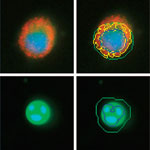 High content analysis (HCA) is a powerful platform that combines cell-based assays with traditional microscopy and automated, sophisticated image processing and analysis software. This technology is capable of using living and fixed cells, typically with fluorescently labeled antibodies and reagents. It has been widely adopted in the pharmaceutical and biotechnology industries for target identification and validation. HCA has made particular inroads into research and development applications where high throughput screening has proven inadequate, such as measuring multiple biological pathways simultaneously, or revealing off-target drug effects. HCA has stepped into this void by demonstrating how particular proteins are affected by the application of a molecule to the cell line of interest.
High content analysis (HCA) is a powerful platform that combines cell-based assays with traditional microscopy and automated, sophisticated image processing and analysis software. This technology is capable of using living and fixed cells, typically with fluorescently labeled antibodies and reagents. It has been widely adopted in the pharmaceutical and biotechnology industries for target identification and validation. HCA has made particular inroads into research and development applications where high throughput screening has proven inadequate, such as measuring multiple biological pathways simultaneously, or revealing off-target drug effects. HCA has stepped into this void by demonstrating how particular proteins are affected by the application of a molecule to the cell line of interest.
May 20th, 2008
 Synthesized carbon nanotubes, especially single-walled carbon nanotubes (SWCNTs), are in the form of bundles with other impurities such as catalyst particles and amorphous carbon debris. In order to be useful for many types of applications, for instance in nanoelectronic devices or biomedical applications, SWCNTs need to be purified and dispersed into individual nanotubes. One method to do this is by surfactant stabilization of the hydrophobic nanotube surface, which overcomes the van der Waals forces among the nanotubes and results in suspensions of individual SWCNTs. Researchers have now investigated the cytotoxicity of SWCNTs suspended in various surfactants. Their experimental results show that the conjugates SDS/CNT and SDBS/CNT are toxic to astrocytoma cells due solely to the toxicity of the SDS and SDBS molecules, which administered alone are toxic to the cells even at a low concentration of 0.05 mg per ml within 30 min. However, the proliferation and viability of the astrocytoma cells were not affected by SWCNTs and the conjugates SC/CNT and DNA/CNT.
Synthesized carbon nanotubes, especially single-walled carbon nanotubes (SWCNTs), are in the form of bundles with other impurities such as catalyst particles and amorphous carbon debris. In order to be useful for many types of applications, for instance in nanoelectronic devices or biomedical applications, SWCNTs need to be purified and dispersed into individual nanotubes. One method to do this is by surfactant stabilization of the hydrophobic nanotube surface, which overcomes the van der Waals forces among the nanotubes and results in suspensions of individual SWCNTs. Researchers have now investigated the cytotoxicity of SWCNTs suspended in various surfactants. Their experimental results show that the conjugates SDS/CNT and SDBS/CNT are toxic to astrocytoma cells due solely to the toxicity of the SDS and SDBS molecules, which administered alone are toxic to the cells even at a low concentration of 0.05 mg per ml within 30 min. However, the proliferation and viability of the astrocytoma cells were not affected by SWCNTs and the conjugates SC/CNT and DNA/CNT.
May 19th, 2008
 Numerous standard setting organizations around the world are active in defining voluntary nanotechnology and nanomaterial standards, although no one standard has achieved dominance yet. These standards address terminology, property testing, and issues of health and safety.
Numerous standard setting organizations around the world are active in defining voluntary nanotechnology and nanomaterial standards, although no one standard has achieved dominance yet. These standards address terminology, property testing, and issues of health and safety.
May 16th, 2008
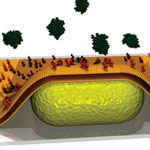 The phenomenon behind many color-based biosensor applications is the excitation of surface plasmons by light - called surface plasmon resonance for planar surfaces or localized surface plasmon resonance (LSPR) for nanoscale metallic structures. Surface plasmon resonance of metallic nanoparticles, in particular gold, has become a popular nanotechnology-enabled technique to build increasingly sensitive and fast biosensors. All the nanostructures used for the biosensing applications have two characteristics: Firstly, they contain certain recognition mechanisms specified to the analyte, for example antibodies or enzymes. Secondly, they are able to generate a distinguishing signal from the analyte and this signal could be generated by the nanostructures themselves or produced by signaling molecules immobilized or contained in the nanostructures. However, proper functionalization remains an issue when it comes to real-world applications, in particular, biological relevant samples such as membrane associated proteins and peptides.
The phenomenon behind many color-based biosensor applications is the excitation of surface plasmons by light - called surface plasmon resonance for planar surfaces or localized surface plasmon resonance (LSPR) for nanoscale metallic structures. Surface plasmon resonance of metallic nanoparticles, in particular gold, has become a popular nanotechnology-enabled technique to build increasingly sensitive and fast biosensors. All the nanostructures used for the biosensing applications have two characteristics: Firstly, they contain certain recognition mechanisms specified to the analyte, for example antibodies or enzymes. Secondly, they are able to generate a distinguishing signal from the analyte and this signal could be generated by the nanostructures themselves or produced by signaling molecules immobilized or contained in the nanostructures. However, proper functionalization remains an issue when it comes to real-world applications, in particular, biological relevant samples such as membrane associated proteins and peptides.
May 15th, 2008
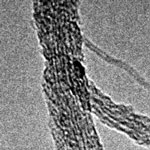 For a decade, researchers and industry professionals have been warning that the limits of silicon were quickly being approached. According to some, these limits have, effectively, already been reached. The age of the integrated microchip circuit - fabricated out of silicon - may be drawing to a close. But, is there any technology ready to fill the void? Is there any technology that could make circuits smaller or more powerful? They answer to this may very well be 'yes.' Although silicon holds numerous properties that make it a rather ideal conductor of electricity under certain conditions, it lacks one crucial characteristic, which may end-up making carbon the material of the future: The ability to form complex, tubular arrays on the scale of only a few nanometers. The age of the integrated nanochip circuit - made-up of composite carbon nanotubes - may have arrived.
For a decade, researchers and industry professionals have been warning that the limits of silicon were quickly being approached. According to some, these limits have, effectively, already been reached. The age of the integrated microchip circuit - fabricated out of silicon - may be drawing to a close. But, is there any technology ready to fill the void? Is there any technology that could make circuits smaller or more powerful? They answer to this may very well be 'yes.' Although silicon holds numerous properties that make it a rather ideal conductor of electricity under certain conditions, it lacks one crucial characteristic, which may end-up making carbon the material of the future: The ability to form complex, tubular arrays on the scale of only a few nanometers. The age of the integrated nanochip circuit - made-up of composite carbon nanotubes - may have arrived.
May 14th, 2008
 Fuel cells have gained a lot of attention because they provide a potential solution to our addiction to fossil fuels. Energy production from oil, coal and gas is an extremely polluting, not to mention wasteful, process that consists of heat extraction from fuel by burning it, conversion of that heat to mechanical energy, and transformation of that mechanical energy into electrical energy. In contrast, fuel cells are electrochemical devices that convert a fuel's chemical energy directly to electrical energy with high efficiency and without combustion (although fuel cells operate similar to batteries, an important difference is that batteries store energy, while fuel cells can produce electricity continuously as long as fuel and air are supplied). Modern fuel cells have the potential to revolutionize transportation. One of the leading fuel cell technologies developed in particular for transportation applications is the proton exchange membrane fuel cell, also known as polymer electrolyte membrane fuel cells - both resulting in the same acronym PEMFC
Fuel cells have gained a lot of attention because they provide a potential solution to our addiction to fossil fuels. Energy production from oil, coal and gas is an extremely polluting, not to mention wasteful, process that consists of heat extraction from fuel by burning it, conversion of that heat to mechanical energy, and transformation of that mechanical energy into electrical energy. In contrast, fuel cells are electrochemical devices that convert a fuel's chemical energy directly to electrical energy with high efficiency and without combustion (although fuel cells operate similar to batteries, an important difference is that batteries store energy, while fuel cells can produce electricity continuously as long as fuel and air are supplied). Modern fuel cells have the potential to revolutionize transportation. One of the leading fuel cell technologies developed in particular for transportation applications is the proton exchange membrane fuel cell, also known as polymer electrolyte membrane fuel cells - both resulting in the same acronym PEMFC
May 13th, 2008
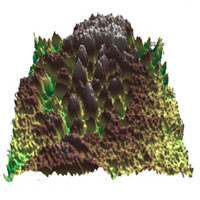 With the advance of nanotechnologies the demand for ever more precise instruments that measure, map and manipulate details at the nanoscale increases as well. For instance, the study of potential distributions with nanoscale resolution becomes increasingly important. In the early days of atomic force microscopy (AFM) the scanning force microscope was used to measure charges, dielectric constants, film thickness of insulating layers, photovoltage, and electrical potential of a given surface. Then, in 1991, the concept of a scanning contact potential microscope was introduced, allowing the simultaneous measurement of topography and contact potential difference. Named the scanning surface potential microscope (SSPM) - also often referred to as Kelvin probe force microscope - this is a variation of the AFM that measures the electrostatic forces (potential) between the probe tip and the surface of a material. Compared with other AFM techniques, the lateral resolution of traditional SSPM, from submicron down to 10 nm, is much lower.
With the advance of nanotechnologies the demand for ever more precise instruments that measure, map and manipulate details at the nanoscale increases as well. For instance, the study of potential distributions with nanoscale resolution becomes increasingly important. In the early days of atomic force microscopy (AFM) the scanning force microscope was used to measure charges, dielectric constants, film thickness of insulating layers, photovoltage, and electrical potential of a given surface. Then, in 1991, the concept of a scanning contact potential microscope was introduced, allowing the simultaneous measurement of topography and contact potential difference. Named the scanning surface potential microscope (SSPM) - also often referred to as Kelvin probe force microscope - this is a variation of the AFM that measures the electrostatic forces (potential) between the probe tip and the surface of a material. Compared with other AFM techniques, the lateral resolution of traditional SSPM, from submicron down to 10 nm, is much lower.
May 12th, 2008
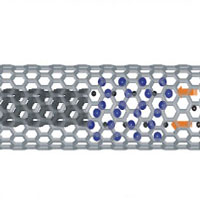 As far as test tubes go, it doesn't get any smaller than a single-walled carbon nanotube (SWCNT). Among the wide range of interesting properties exhibited by SWCNTs is their capacity to encapsulate molecules within their quasi one-dimensional cavity. The confinement offered by the nanotube could serve as a nanoscale test tube to constrain a chemical reaction. This was demonstrated in principle back in 1998, when the coalescence of adjacent fullerenes was observed by transmission electron microscopy. In the following years, scientists have extensively experimented with filling nanotubes with other fullerenes, atoms, molecules and, very recently, with organic molecules. Owing to their large variety with diverse chemical properties, the incorporated organic molecules can tune the properties of the SWCNTs. Scientists are intrigued by the possibilities that SWCNTs' use as a reaction tube offers for chemistry at the nanoscale. Nanochemistry - a key to control self-assembly processes prerequisite for nanotechnology - in essence would produce stable chemical reactions inside a confined nanoscale space. Encapsulated inside this nanoscale space, molecules are isolated from the outside environment, which allows one to identify and control the source and incidence of chemical reactions. Recent work has demonstrated this new chemistry by using SWCNTs as a nanometer-scale reaction furnace.
As far as test tubes go, it doesn't get any smaller than a single-walled carbon nanotube (SWCNT). Among the wide range of interesting properties exhibited by SWCNTs is their capacity to encapsulate molecules within their quasi one-dimensional cavity. The confinement offered by the nanotube could serve as a nanoscale test tube to constrain a chemical reaction. This was demonstrated in principle back in 1998, when the coalescence of adjacent fullerenes was observed by transmission electron microscopy. In the following years, scientists have extensively experimented with filling nanotubes with other fullerenes, atoms, molecules and, very recently, with organic molecules. Owing to their large variety with diverse chemical properties, the incorporated organic molecules can tune the properties of the SWCNTs. Scientists are intrigued by the possibilities that SWCNTs' use as a reaction tube offers for chemistry at the nanoscale. Nanochemistry - a key to control self-assembly processes prerequisite for nanotechnology - in essence would produce stable chemical reactions inside a confined nanoscale space. Encapsulated inside this nanoscale space, molecules are isolated from the outside environment, which allows one to identify and control the source and incidence of chemical reactions. Recent work has demonstrated this new chemistry by using SWCNTs as a nanometer-scale reaction furnace.
May 9th, 2008
 High content analysis (HCA) is a powerful platform that combines cell-based assays with traditional microscopy and automated, sophisticated image processing and analysis software. This technology is capable of using living and fixed cells, typically with fluorescently labeled antibodies and reagents. It has been widely adopted in the pharmaceutical and biotechnology industries for target identification and validation. HCA has made particular inroads into research and development applications where high throughput screening has proven inadequate, such as measuring multiple biological pathways simultaneously, or revealing off-target drug effects. HCA has stepped into this void by demonstrating how particular proteins are affected by the application of a molecule to the cell line of interest.
High content analysis (HCA) is a powerful platform that combines cell-based assays with traditional microscopy and automated, sophisticated image processing and analysis software. This technology is capable of using living and fixed cells, typically with fluorescently labeled antibodies and reagents. It has been widely adopted in the pharmaceutical and biotechnology industries for target identification and validation. HCA has made particular inroads into research and development applications where high throughput screening has proven inadequate, such as measuring multiple biological pathways simultaneously, or revealing off-target drug effects. HCA has stepped into this void by demonstrating how particular proteins are affected by the application of a molecule to the cell line of interest.
 Subscribe to our Nanotechnology Spotlight feed
Subscribe to our Nanotechnology Spotlight feed





